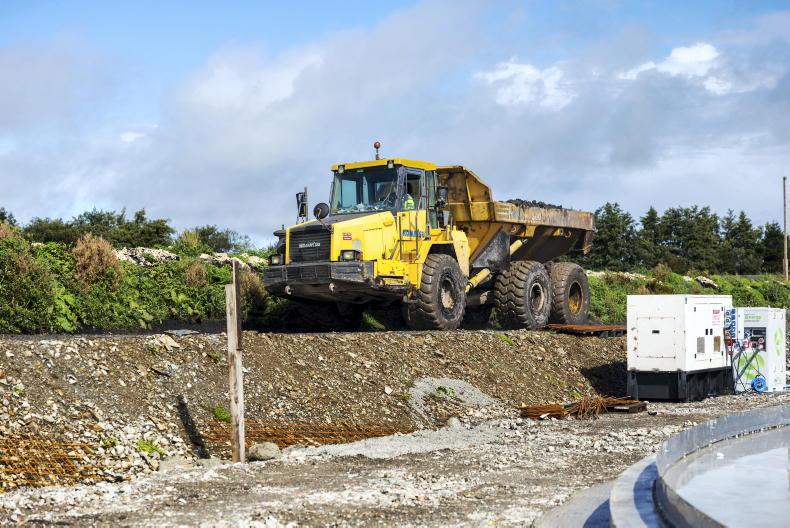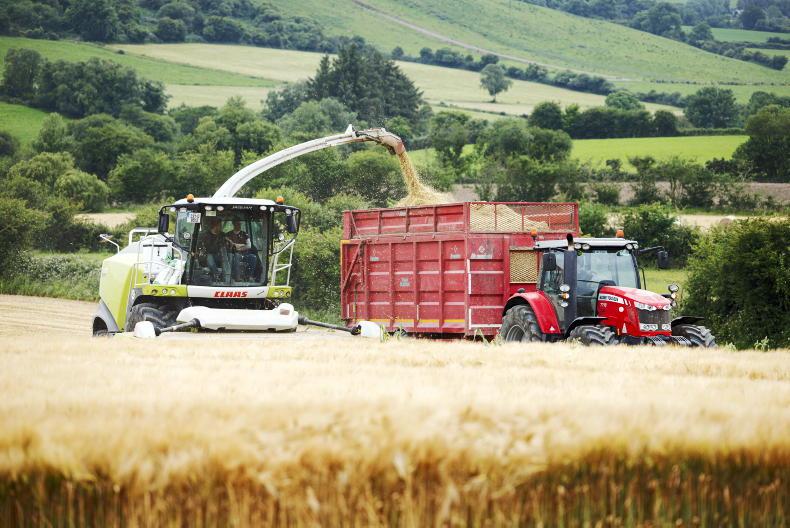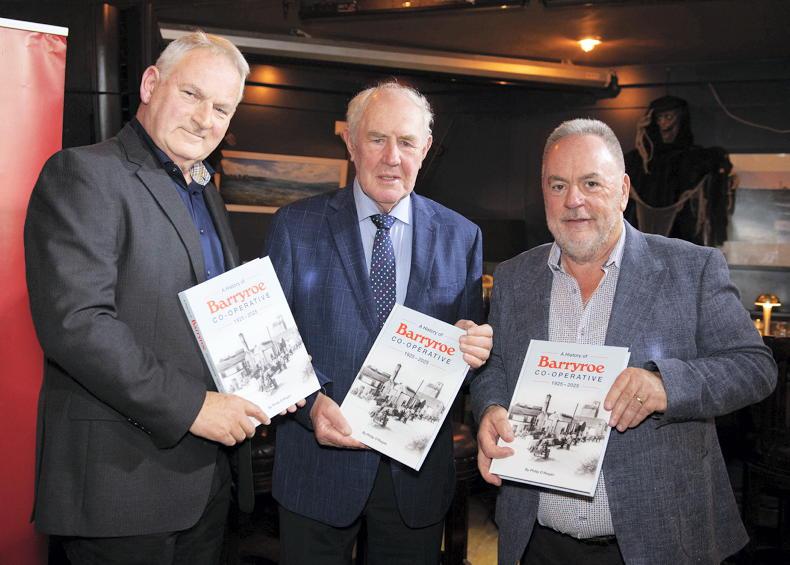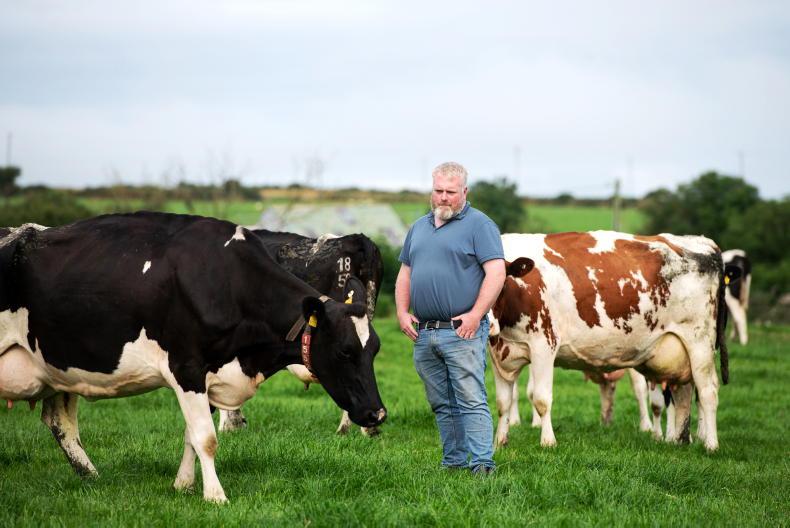Biorefinery GLAS is a demonstration of a new small-scale biorefinery that is capable of processing two tonnes of grass per hour to extract more of its valuable components. The biorefinery itself sits comfortably on the back of an articulated lorry trailer. It is self-contained with its own diesel generator.
Grass is fed into a turnscrew press via a hydraulic feed box at the rear of the trailer. The press separates the grass into solids and liquids.
The solid is called press cake and leaves the machine via a conveyor. From a distance, it looks like a combination of lawn-cutting and moss. On closer inspection of this sweet smelling substance, the dry matter and veins from grass are clearly visible.

Harvested grass ready for processing in the biorefinery. \ Donal O'Leary
The liquid product is fed into tanks for storage and eventually settles into a liquid and solid state.
“We’re trying to displace a large portion of the soya bean or GMO feed imports by improving the availability of indigenous animal feed, especially proteins,” said project co-ordinator James Gaffey, principal investigator in bioeconomy at Institute of Technology, Tralee. “We’re attempting to demonstrate a solution that improves the protein efficiency of Irish grassland and creating an additional protein product.”
The Leitrim native added that it would provide an opportunity for pig and poultry farmers to benefit from a bioeconomy approach to grass in the livestock sector.

The solid fraction of grass is called press-cake. \ Donal O'Leary
Another potential environmental benefit is the use of residue from grass refining as a biofertiliser or as a co-substrate in anaerobic digestion to produce renewable energy, said Gaffey.
“At the moment there’s a big push for grass-to-gas in Ireland. Our approach is to see if we can extract the protein from grass first and produce energy from the material later,” he said.
One-third of overall greenhouse gas emissions in Ireland come from agriculture and replacing fossil fuels with bioenergy can be a solution to balancing that. But Gaffey said the Biorefinery GLAS project also offers solutions to nutrient release into water.
“When we feed cattle a fibre product which comes from our biorefinery, the overall nitrogen contained within that fraction is lower than in silage,” he said.
“It’s less prone to break down and it’s converted to milk at a higher nitrogen-to-milk efficiency.”
Gaffey added that the amount of phosphorus that enters the cow is also lower but better used.
“The nitrogen and phosphorus that leave the cow in terms of excrement is also at a lower level,” he said.
IT Tralee, Carbery group, Barryroe Co-op, UCD and Wageningen University in the Netherlands are all involved in this European Innovation Partnership project funded through the Department of Agriculture.
Refining grass into four products
1
The first product from the process is called press-cake fibre: similar to haylage, it contains 60% of the protein in grass in the form of insoluble protein, which is less prone to break down in the rumen and can be converted to milk.
Based on studies in the Netherlands and at Aarhus university in Denmark, the levels of milk productivity and quality from press-cake are parallel with silage even if the level of nitrogen intake is lower because the conversion rate is better.
2
About 40% of the protein is in the form of soluble protein: this is dried to form a storable feed with 90% dry matter.
It has similar amino acid composition to dehulled soya bean, with slight variations and is suitable for feeding to pigs or poultry. Barryroe Co-op will trial this as a pig feed through its mill. The co-op will carry out the pig feed trials and make comparisons with other pig feed ingredients that it currently supplies.
3
A sugar product: about 30% to 70% of the sugars in grass are in the form of fructo-oligosaccharides.
These are a potential prebiotic for use in animal or human nutrition and are also an ingredient in cosmetics. This is a potentially small volume, high-value product coming out of the process in addition to bulk marketable protein products.
4
A solution called grass whey: containing a lot of minerals, this will be trialled in two ways. Firstly, it will be applied as a biofertilser comparing it with standard fertilisers. It will also be assessed as a biogas substrate for use in anaerobic digestion.
Get more value from your grass – Carbery
Enda Buckley, director of sustainability at the Carbery Group, told the Irish Farmers Journal his co-op was involved in the project for a number of reasons: “Principally to see the process in action in an Irish context and also to see if it stacks up as a viable option in terms of getting more value from grass.” Buckley said Carbery is always looking to extract more value for shareholders and the biorefinery could contribute to this. “If these trials work out, it would be envisaged that the mobile grass biorefinery would be used on the silage platform,” he said.
“The climate action plan has imposed challenging targets on agriculture and we will have to come up with new ways to be carbon-efficient. In principle at least, this biorefinery will tick a lot of those boxes.”
Demo day
The Biorefinery GLAS project is holding a free, KT-approved open day this Thursday 11 July at Teagasc and Carbery’s Shinagh demonstration farm in Bandon, Co Cork. Tours start at 11am and 2pm. Details and tickets are available online at ifj.ie/shinagh
Read more
Watch: how to grow greener grass
More grass, less gas: fertiliser and multi-species swards trials
Biorefinery GLAS is a demonstration of a new small-scale biorefinery that is capable of processing two tonnes of grass per hour to extract more of its valuable components. The biorefinery itself sits comfortably on the back of an articulated lorry trailer. It is self-contained with its own diesel generator.
Grass is fed into a turnscrew press via a hydraulic feed box at the rear of the trailer. The press separates the grass into solids and liquids.
The solid is called press cake and leaves the machine via a conveyor. From a distance, it looks like a combination of lawn-cutting and moss. On closer inspection of this sweet smelling substance, the dry matter and veins from grass are clearly visible.

Harvested grass ready for processing in the biorefinery. \ Donal O'Leary
The liquid product is fed into tanks for storage and eventually settles into a liquid and solid state.
“We’re trying to displace a large portion of the soya bean or GMO feed imports by improving the availability of indigenous animal feed, especially proteins,” said project co-ordinator James Gaffey, principal investigator in bioeconomy at Institute of Technology, Tralee. “We’re attempting to demonstrate a solution that improves the protein efficiency of Irish grassland and creating an additional protein product.”
The Leitrim native added that it would provide an opportunity for pig and poultry farmers to benefit from a bioeconomy approach to grass in the livestock sector.

The solid fraction of grass is called press-cake. \ Donal O'Leary
Another potential environmental benefit is the use of residue from grass refining as a biofertiliser or as a co-substrate in anaerobic digestion to produce renewable energy, said Gaffey.
“At the moment there’s a big push for grass-to-gas in Ireland. Our approach is to see if we can extract the protein from grass first and produce energy from the material later,” he said.
One-third of overall greenhouse gas emissions in Ireland come from agriculture and replacing fossil fuels with bioenergy can be a solution to balancing that. But Gaffey said the Biorefinery GLAS project also offers solutions to nutrient release into water.
“When we feed cattle a fibre product which comes from our biorefinery, the overall nitrogen contained within that fraction is lower than in silage,” he said.
“It’s less prone to break down and it’s converted to milk at a higher nitrogen-to-milk efficiency.”
Gaffey added that the amount of phosphorus that enters the cow is also lower but better used.
“The nitrogen and phosphorus that leave the cow in terms of excrement is also at a lower level,” he said.
IT Tralee, Carbery group, Barryroe Co-op, UCD and Wageningen University in the Netherlands are all involved in this European Innovation Partnership project funded through the Department of Agriculture.
Refining grass into four products
1
The first product from the process is called press-cake fibre: similar to haylage, it contains 60% of the protein in grass in the form of insoluble protein, which is less prone to break down in the rumen and can be converted to milk.
Based on studies in the Netherlands and at Aarhus university in Denmark, the levels of milk productivity and quality from press-cake are parallel with silage even if the level of nitrogen intake is lower because the conversion rate is better.
2
About 40% of the protein is in the form of soluble protein: this is dried to form a storable feed with 90% dry matter.
It has similar amino acid composition to dehulled soya bean, with slight variations and is suitable for feeding to pigs or poultry. Barryroe Co-op will trial this as a pig feed through its mill. The co-op will carry out the pig feed trials and make comparisons with other pig feed ingredients that it currently supplies.
3
A sugar product: about 30% to 70% of the sugars in grass are in the form of fructo-oligosaccharides.
These are a potential prebiotic for use in animal or human nutrition and are also an ingredient in cosmetics. This is a potentially small volume, high-value product coming out of the process in addition to bulk marketable protein products.
4
A solution called grass whey: containing a lot of minerals, this will be trialled in two ways. Firstly, it will be applied as a biofertilser comparing it with standard fertilisers. It will also be assessed as a biogas substrate for use in anaerobic digestion.
Get more value from your grass – Carbery
Enda Buckley, director of sustainability at the Carbery Group, told the Irish Farmers Journal his co-op was involved in the project for a number of reasons: “Principally to see the process in action in an Irish context and also to see if it stacks up as a viable option in terms of getting more value from grass.” Buckley said Carbery is always looking to extract more value for shareholders and the biorefinery could contribute to this. “If these trials work out, it would be envisaged that the mobile grass biorefinery would be used on the silage platform,” he said.
“The climate action plan has imposed challenging targets on agriculture and we will have to come up with new ways to be carbon-efficient. In principle at least, this biorefinery will tick a lot of those boxes.”
Demo day
The Biorefinery GLAS project is holding a free, KT-approved open day this Thursday 11 July at Teagasc and Carbery’s Shinagh demonstration farm in Bandon, Co Cork. Tours start at 11am and 2pm. Details and tickets are available online at ifj.ie/shinagh
Read more
Watch: how to grow greener grass
More grass, less gas: fertiliser and multi-species swards trials












SHARING OPTIONS